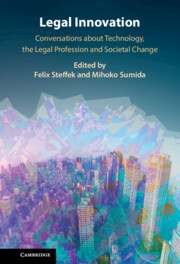This book is an experiment. It addresses the complex topic of legal innovation with a specific focus on technology, the legal profession and societal change. Particular consideration is given to artificial intelligence. The style of this book is, however, different from the typical form of academic publications. The chapters come in the form of conversations. Leading experts from ministries, international organisations, academia, legal practice, start-ups and regulators present their thoughts and comments and engage in discussions with a group of students. The topics dealt with remain challenging, but we hope that the style of presentation makes the book an accessible and entertaining read.
Why are we interested in legal innovation? Recent technological advances are transforming the way we use and experience law and the justice system. Artificial intelligence is used to predict the outcome of court proceedings and legal chatbots explain the law. However, it is not only technology impacting the law; law can also facilitate innovation and even effect it. We wanted to discuss this transformation with those making the law, advising clients and analysing current changes. Hence, we invited experts, mainly based in Japan and the United Kingdom, to offer their perspectives on legal innovation.
What topics does this book cover? The chapters investigate the motivation and conditions for legal innovation, the impact of technology on dispute resolution, corporate governance, financial services and regulatory oversight. The conversations also address the success factors and barriers for entrepreneurs and legal practitioners innovating the law. A final round table brings together policymakers for a discussion about the impact of technology on access to justice. Legal innovation is considered from a range of perspectives including not only legal considerations but also economic, environmental, social and justice viewpoints.
Why are we presenting this book in the form of conversations? All experts presented their views in a setting that involved comments and questions. The sessions took place in 2021, in the midst of the COVID-19 pandemic, via videoconferencing. Key presentations were followed by comments from other experts. Then, students of Hitotsubashi University, Tokyo, were invited to ask critical questions. When we looked at the transcripts of the eight sessions, we thought that there is a special value in the conversational form. It reveals how experts are searching for answers in a fast-moving field and the discussions bring out interesting contrasts and nuances.
How did the session transcripts become this book? We changed as little as necessary. Hence, the chapters are documents of conversations that took place at a certain time, in the first half of 2021. While the speakers reviewed the chapters, no rewriting took place. However, we have cleaned the language for a better reader experience. Selected figures and slides from the presentations are included, and a few footnotes referring to useful information have been added. The texts reflect the dynamic between speakers and students, and we hope that the conversational style reflects well the joint effort to explore legal innovation while giving room for different perspectives. As editors, we have added a concluding conversation to each chapter and a list of questions for further thought.
Finally, we would like to thank all speakers and students contributing to the conversations. They all shared their thoughts in an open atmosphere driven by curiosity. We had the best speakers we could hope for. We are also grateful to the outstanding translators of NHK Global Media Services, who made communication possible and provided us with the transcripts that became the starting point for this endeavour. This book is part of the UK Economic and Social Research Council (ESRC) and Japan Science and Technology Agency (JST) funded project on ‘Legal Systems and Artificial Intelligence’. We also received generous financial support from the Graduate School of Law of Hitotsubashi University and Newnham College of the University of Cambridge. We would like to thank the team at Koubundou with whom we have published a prior version of this book in Japanese in 2022. Last, but not least, we are grateful to Matt Gallaway and Jadyn Fauconier-Herry of Cambridge University Press, who guided us expertly towards publication. Nikhil Purohit and Quentin Schäfer have provided excellent editorial assistance.

